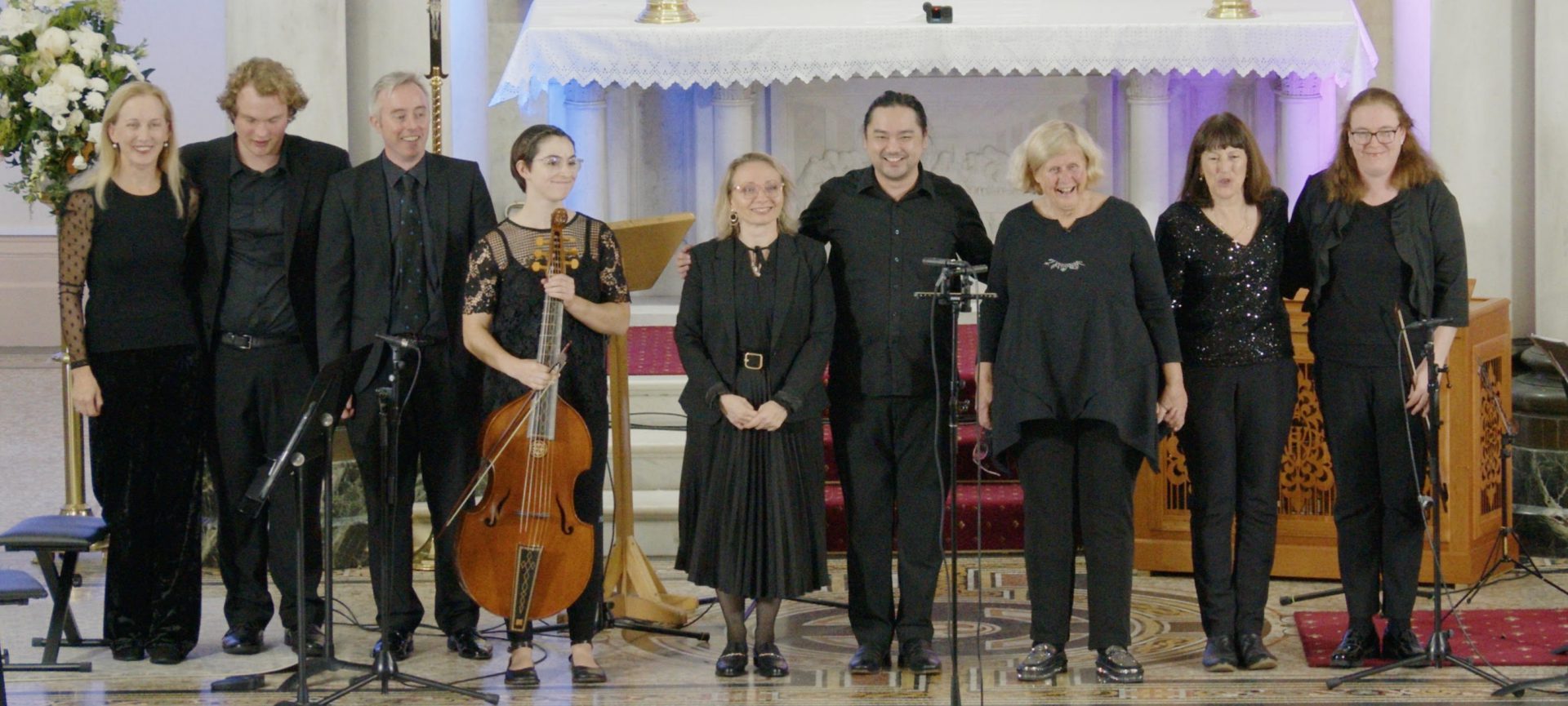This concert was performed in St Brigid’s Marrickville, which is steeped in the Passionist tradition.
But it centred upon the soundworld of the North German baroque post-Luther. The works of Schütz which opened this concert showed that the Lutheran movement had developed a mystical or quietist flavour.
Schütz’s motet “Ego dormio et cor meum vigilat” is no exception. In the beginning, it was difficult to discern a sense of rhythmic continuity. But with tenor Richard Butler taking the helm with direction a shape soon became clear. That is no mean feat. This is a busy work. The stretto is tight. Very soon after Butler introduces the theme, David Greco as bass sings the inversion. And alto and soprano are soon lathered over, with meandering countersubjects abound. Like most late Renaissance or early Baroque devotional motets, the phrasing is short, reflecting the brevity of most sacred verses.
The same stretto can be seen in the next motet, Vulnerati cor meum. It is a text from the Song of Songs which was set by the likes of Palestrina and Buxtehude. It is a madrigal in the garb of a motet. The voices follow each other less than half a bar in each and imitate each other throughout. Countertenor, Will Varga, despatches a tremolo to great dramatic effect. That is no gratuitous flourish. It is in the fine tradition of using tremolos to depict anguish, and in no less fitting a setting as one that speaks of a wounded heart.
Then emerged Karen Carey and Susan Sukkar on baroque recorders. Again, at times it was hard to get a sense of the rhythm to start with. But that is a difficulty inherent in recorders suites without the grounding provided by continuo. There were staccato passages where each player rose step-wise, imitating each other coyly. In fact, imitation was the hallmark of this peace, in each of the four movements. The Allegro featured some almost canonic imitation, with delicious rising and falling chromatic passages.
Good things come in twos. So came Shaun Ng and Ruby Brallier, with Schenck’s Sonata no 3 in D major for 2 viols da gamba (Le Nymphe di Rheno). The mellow earthiness of the viol da gamba was on full display. In the third movement, Ng makes tasteful use of vibrato to give a song-like effect to key passages.
Kurt Ison on organ literally turned heads with his performance of Buxtehude’s Passacaglia in D minor BuxWV 161. It has a theme that strikingly foreshadows the ground in Bach’s famous passacaglia in C minor. Ison’s playing was solid, constant and had a strong sense of momentum. His articulation was good and this put on full display the very North German art of variation, shifting metres and changing registrations abound, of which the likes of Buxtehude, Sweelinck and Scheidt were masters.
After a short interval came the crown jewel of the program – Bach’s Actus Tragicus, or “Gottes Zeit ist die Allerbeste Zeit”. It is a cantata written by a teenaged Bach for the funeral of a relative. Although a funeral cantata, it is very different in style to his later “Lass Furstin” cantata. It is less florid, more compact and has a keen sense of artistic economy – all the hallmarks of an early Baroque German occasional motet. The delightful sinfonia features a distinctive motif exchanged between the recorders like cooing doves. There comes a time in the “Ach, Herr, lehre uns bedenken” aria when the tenor must sing a loud and high “Auf das” which often becomes an excruciating shriek. Not so with Butler. It was soft and mellifluous. David Greco gave a characteristically animated rendition to an aria which has the strong flavour of Old Testament admonition.
This is an incredibly well-designed cantata. The phrase “Es ist die alte Bund” (it is the ancient Law”) is sung with strict, canon-like, counterpoint (“canon”, of course, meaning law). As it so often is, the “Es ist die alte Bund” was the moment for soprano, Josie Ryan, to shine with repetitions of “Ja, komm, Herr Jesu!”. The final “Jesu” is a melisma which Ryan sang with vibrato and with such pathos that it dissolved into thin air. This marks the half-way point of the cantata, the veritable fulcrum after which the tone changes to salvation. The ensemble realised this confronting the audience with silence for a good few sentences, before delving into the “In deine Hande”. The Heute wirst is designed smartly. It begins with an intricate dialogue between Greco and the cellos, but, Ryan and Varga join in unison to overlay the familiar hymn-tune “Mit Fried und Freud ich fahr dahin” as cantus firmus. Their performance of the cantus firmus was beautifully delicate. It is all rounded off with a closing “Amen” on the recorders, which, despite a few slips, was a delightful way to end.
The ensemble stuck to authenticity by getting the audience to sing the hymn “All Glory, Laud and Honour”. This was a great way to get a lay audience to not only understand, but viscerally feel, what is going on in Bach’s choral prelude “Valet will Ich dir geben” (BWV 736) for solo organ. Again, Ison’s performance was solid and unpretentious. The voices were not confused. And it became clear that the hymn tune appeared in the pedals episodically.
